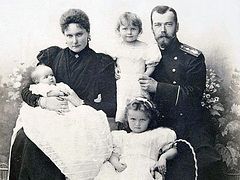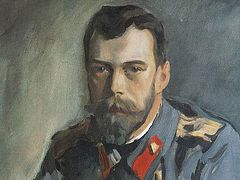This homily from Metropolitan (Archimandrite at the time) Tikhon (Shevkunov) was delivered on the feast of the Royal Martyrs in 2014.
In the name of the Father and of the Son and of the Holy Spirit.
Exactly twenty years ago, we celebrated the first Divine Liturgy оn this night here in the then newly-opened Sretensky Monastery—the night of the murder of the Royal Family. The tsar was not yet canonized then, and there were many doubts, and even sometimes slander (although, slander still continues today), and there were objections to the canonization of the Royal Family.
We served the Liturgy then, remembering the Royal Family and their companions at the Litany for the Departed, and then, after the Liturgy, we served a panikhida. We very much wanted the glorification of the Tsar-Martyr, the Tsar-Passion-bearer to take place, because many then, not only in Russia, but throughout the entire Russian diaspora, and not only Russians from the Russian Church, but many Orthodox people from other Local Churches understood that despite any difficulties in his reign, despite any internal temptations and doubts that temporarily accompanied any reflection upon it, and even moreso, despite any slander built up against the Tsar and his family, they were absolutely unique people in the history of our Church and state.
The desire to understand them and to somehow deeply feel their podvig was the basis for the appearance in our church of this icon, which we titled the Opening of the Fifth Seal. It was prohibited then to depict the Tsar-Martyr as a saint, because he was not yet glorified. But we took the story from the Book of the Revelation of the opening of the fifth seal. When the angel committed this great act, so mysterious for us, then the seer of mysteries [St. John the Theologian—O.C.] saw under the altar of God the soul of those murdered for their witness to God. This is what we depicted on this icon, painting precisely this portion from Revelation, and then we humbly waited for their glorification by the Church.
I remember when the reposed Patriarch, His Holiness Alexei (may God grant him the Heavenly Kingdom) first came to serve here after we placed this icon here. He was sensing the solea, when suddenly his gaze fell upon this icon. We all froze, because, of course, it was not completely according to the rules. Although, it was according to the rules, because it does not say, “Holy Martyrs,”1 although, everyone knew who it was, of course. His Holiness Patriarch Alexei grunted a little and continued censing. Then he asked us what the icon was about. I explained it to him in detail about the icon, and he said, “Well, alright.”
And within a few years, the Royal Martyrs were glorified. We know a lot about them, we talk a lot about them, and we are still learning about them, but they were glorified. But what is a canonization? A canonization is the elevation to canon, that is, to Church law, of the already-existing veneration of the saints. It undoubtedly existed, but there remained only for the Church to recognize the legitimacy of this veneration. (Of course, we know that not all veneration is legitimate). Thank God that our Church has committed this great act, and now we cannot even imagine our Church without these great, dear saints, so close to us, so touching, brave, faithful, and absolutely invincible in their humility and faith.
O holy Royal Martyrs, pray to God for us. May God save you.








